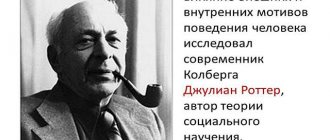What is the deductive method?
The deductive method (from Latin deductio - deduction) is a method of thinking , the consequence of which is a logical conclusion, where a particular conclusion is deduced from the general. The whole essence of the deductive method is that a person begins to build a logical chain based on a hypothesis, the accuracy of which he has no doubt. In order to prove a hypothesis, it is necessary to make observations and draw conclusions. In the process of observation, generally accepted and recognized facts are applied.
To make it easier to understand what the deductive method is, let's turn to the book “Thinking Slow... Solve Fast,” authored by Nobel Prize winner Daniel Kahneman. The book describes the so-called “fast thinking,” which is responsible for instantaneous awareness of the surrounding space. This type of thinking forces a person to classify his instinctive sensations. Based on this, a person most often makes irrational decisions that turn out to be wrong.
In order to ensure the conscious formation of thoughts, decisions, conclusions and assessments, it is necessary to use a system of “slow” thinking. How does this manifest itself? For example, a woman found her husband's wedding ring on the living room table. The first impulse, of course, will be to get angry with your spouse and suspect him of all mortal sins. However, the woman immediately remembers that a light bulb in their living room had burned out, and she asked her husband to replace it. The light in the room is on, which means the man has fulfilled the request. It follows that he had to bring a stepladder and tools from the garage. Because the man had to wear gloves, he took off the ring to make it easier for him. Afterwards, he simply forgot to put it on because he was late for work. The reason was found, a family quarrel was avoided - this is an example of “slow” thinking, which helped the woman see all the details and come to the right conclusion.
This type of thinking is the basis of the deductive method. Deduction allows you to draw a particular conclusion based on general facts. Let's take the same gold ring. We know that all metals are capable of conducting current, and gold is undoubtedly a metal. From this we can conclude that a gold ring is also capable of passing current. We applied knowledge from the general education school curriculum and made a private conclusion. In doing so, we used the deductive method of thinking.
Develop voluntary and involuntary attention
The development of all types of attention is necessary in order not to miss important details, to interpret them correctly, without being distracted by extraneous stimuli.
It is necessary to develop all possible types of attention: both voluntary and involuntary.
Voluntary attention is the ability of a subject to concentrate on one subject and not be distracted by anything else. It is believed that a person is able to maintain his attention on an object for a maximum of 20 minutes. For example, the master of deduction Sherlock Holmes played the violin, smoked a pipe, or was alone in order to concentrate.
Stop multitasking: the more factors affect your sensory organs, the more difficult it is to focus on one thing. By dealing with several problems at once, you will make more mistakes and miss a large amount of important information.
Involuntary attention is considered a kind of peripheral vision. To develop it, you need to regularly observe familiar objects in unusual conditions. For example, with a different sound background or lighting.
Examples of the deductive method
Deductive thinking has been around since the time of Aristotle, who analyzed every conclusion along with its premises and conclusion. Cognition through the deductive method is based on the relationship of the constituent components.
Let's go back to the example with the gold ring. Hypothesis A states that all metals carry current. If this hypothesis is correct, then hypothesis B that gold, like a metal, also passes current, is correct. So the B hypothesis follows from the A hypothesis. If someone manages to prove that gold does not transmit current, then this will mean that hypothesis B is incorrect. From this we can conclude that judgment A will also be erroneous.
Judgments that contain statements of immutable truths are premises. In our example, these are “metals pass current” and “gold is a metal.” Judgments that follow from the premises and put a logical point are a conclusion, or a consequence. “Gold also passes current”—that’s the conclusion.
Basic output forms
Let's consider the basic forms of reasoning characteristic of logical thinking. There are not so many such forms: these are induction, deduction and analogy. They can be briefly characterized as follows.
Induction is an inference about a set based on consideration of the individual elements of that set.
In contrast, deduction is an inference about an element based on knowledge of certain qualities of the set in which it is included.
An analogy is an inference about an element (set) that conveys to it the properties of another element (set). Let's look at each method separately.
Differences from the inductive method
The inductive method is the exact opposite of the deductive method, and is based on the transition from the particular to the general. This can be observed more clearly in medicine, when a doctor, based on the patient’s symptoms, makes a diagnosis. From a deductive point of view, the whole “picture” must first be assessed in order to reach a correct conclusion. Using this method, the doctor must first use the general term “cold” and work from there. Influenza means that a person must have symptoms.
If we talk about differences, it should be mentioned that deductive thinking is more generalizing and global. Inductive thinking is based on subjective hunches. However, both methods are interrelated. At the beginning, until a common feature is discovered in various phenomena, the movement occurs from the particular to the general, that is, induction is used. By combining particular cases, induction allows us to obtain general knowledge. After establishing a general feature, thinking goes in the opposite direction - from the general to the specific. This is a deductive method.
Examples of deductive logic in Conan Doyle's novel and McGuigan's Sherlock Holmes series
What deduction is in the artistic interpretation of Paul McGuigan becomes clear in the following examples.
A quote that embodies the deductive method from the series: “This man has the bearing of a former military man. His face is tanned, but this is not his skin tone, since his wrists are not so dark. The face is tired, as if after a serious illness. He holds his hand motionless, most likely he was once wounded in it.” Here Benedict Cumberbatch uses the method of inference from the general to the specific. Often deductive conclusions are so limited that they can only be guessed at. It can be difficult to restore deduction in full, indicating two premises and a conclusion, as well as logical connections between them.
Quote from detective Conan Doyle: “Because I have been using deductive logic for so long, conclusions arise in my head so quickly that I do not even notice intermediate conclusions or relationships between two positions.”
Where is deduction used?
Every day, when faced with various circumstances, our brain builds logical chains that are invisible to many. When deciding what to wear in the morning, we study the weather outside the window. We have two messages in our heads: it’s cold outside, and warm clothes protect us from the cold. These are two general knowledges. Based on this, we come to the understanding that we need to dress warmly - this is the conclusion.
The deductive method is present in our everyday life, but we may not understand it. However, when it comes to professional activities, a person consciously uses deduction to solve specific problems. The method of deductive thinking is used in many directions:
- disputes and discussions - using deduction, obvious statements are given with which the opponent has to agree, thereby accepting your point of view;
- mathematics - a good example is geometric problems from the school curriculum. To prove the theorem, the student must use generally accepted and proven axioms;
- philosophy - the whole essence of the deduction method here is that any hypothesis must be substantiated using only logical evidence;
- forensics - upon arriving at the crime scene, the expert uses the overall picture of the incident. This helps him find individual circumstances and new details;
- science - a scientist takes as the basis of his work some hypothesis that has not yet been proven or disproven. Based on the hypothesis, the scientist derives consequences that he will try to discover during the research.
Introduction
Knowledge plays an important role in our lives, and scientific methods of obtaining knowledge are very diverse, but closely related to each other.
Rational judgments are traditionally divided into deductive and inductive. The question of using induction and deduction as methods of knowledge has been discussed throughout the history of philosophy. Unlike analysis and synthesis, these methods were often opposed to each other and considered in isolation from each other and from other means of cognition.
In modern scientific knowledge, induction and deduction are always intertwined with each other. Real scientific research occurs in the alternation of inductive and deductive methods; the opposition of induction and deduction as methods of knowledge loses its meaning, since they are not considered as the only methods. Other methods play an important role in cognition, as well as techniques, principles and forms (abstraction, idealization, problem, hypothesis, etc.). For example, probabilistic methods play a huge role in modern inductive logic. Assessing the likelihood of generalizations and searching for criteria for substantiating hypotheses, the establishment of complete reliability of which is often impossible, require increasingly sophisticated research methods.
How to learn to think deductively?
We've talked before about the slow mindset. If you want to learn the deductive method, you will need to be observant. Be “corrosive”, try to pay attention to even the most inconspicuous details. Start small, for example, by studying the arrangement of furniture in a room when you are visiting someone. When talking to a person, pay attention to how he talks, gestures, and where he looks. Over time, you will learn to notice what is hidden from prying eyes.
If you don't have a small notebook, now is the time to buy one. Carry it with you always to record all your observations. Over time, spatial descriptions will turn into iron facts. Don't forget that you will need an extensive knowledge base. Expand your horizons every day: read, watch films and listen to music of different genres, travel, meet people of different professions and interests.
Is this real
It's worth starting with something encouraging.
Sherlock Holmes' abilities are absolutely real. And in general, the legendary character was copied by Conan Doyle from a living person - professor at the University of Edinburgh Joseph Bell. He was widely known for his ability to guess a person's character, background and profession from the smallest details. On the other hand, the existence of one real outstanding person does not guarantee success for everyone who tries to repeat his achievements. Mastering abilities comparable to Holmes's is incredibly difficult. In a different scenario, Scotland Yard wouldn't be running around Baker Street for clues, right?
Conan Doyle's mistake
In fact, deduction is far from the main tool used by Sherlock Holmes. In general, in his books he used this method, perhaps most rarely, preferring other methods of constructing logical chains that were more suitable for the tasks of the investigation. However, we will talk about them later.
Strangely enough, some lack of education of Sir Arthur Conan Doyle, who preferred to use the definition of “deduction” in the wrong context, is to blame for everything.
The very image of Sherlock Holmes was inspired by the writer from his acquaintance at the university, who was an extremely reserved young man. This student, studying to become a pathologist, spent all his time in the morgue, among the corpses. His main hobby was examining victims of violent deaths, after autopsy of which he, as a rule, made brilliant conclusions and found evidence hidden from the eyes of the “regular” morgue workers. He passed on all his discoveries to the police, while often complaining to his friend Arthur about the lack of education and stupidity of the policemen, who were unable to solve even basic crimes.
He, like Sherlock Holmes, taught his friend Dr. Conan Doyle (of course, from whom the image of Watson was copied) what he would later immortalize in his books, giving the name “theory of deduction.”










